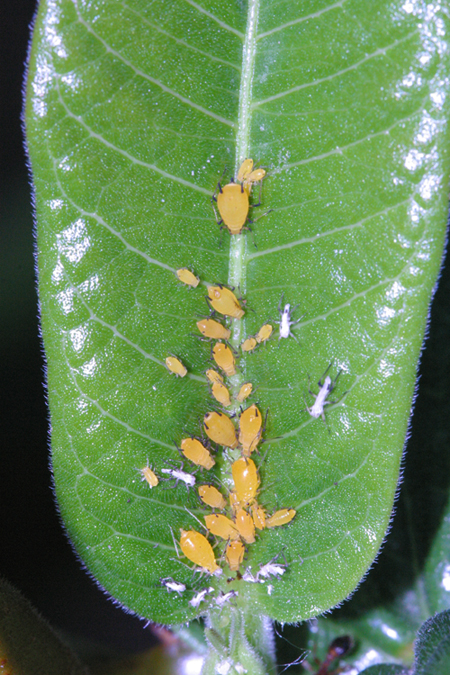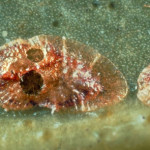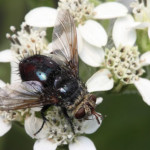- The ensign wasp lays its eggs in the egg cases of cockroaches.
- These tiny braconid wasps do not completely consume their tomato hornworm host before spinning dozens of pupal cocoons over their victim.
- Some parasitoids, such as this bethylid wasp are egg parasitoids, small enough to grow up inside a single insect egg.
- Ichneumon wasps were among the first parasitoids discovered. They attack caterpillars.
- The holes in this scale insect were left behind by emerging parasitoid wasps.
- Tachinid flies are another kind of parasitoid. They attack caterpillars and, sometimes, snails.
The words “beneficial” and “parasite” are not normally heard together. But when talking about gardens, and parasitic wasps that attack pests, the word pairing makes good sense.
Many insects in both natural settings and the urban landscape have long been recognized by humans as “beneficial”, as in benefiting man. Predators of pest insects, in particular, have attracted admiring fans, especially farmers. As early as ninth century China, farmers were modifying their orchards to aid the transfer of predator ants for control of citrus pests. By the 18th century birds, ground beetles and lady beetles were recognized as important controllers of pests. Today when someone mentions good bugs, most gardeners quickly point to dragonflies, green lacewings, preying mantids and lady beetles as brave defenders of the garden.
But in addition to these relatively large and showy predators, a whole class of helpful garden insects often are unnoticed, unappreciated, and (sometimes) abused. They are the beneficial parasites, or more correctly, “parasitoids” of the garden. In nature parasites usually only weaken or sicken their hosts. Parasitoids kill and actually consume their prey. Unlike predators which are highly mobile and consume multiple prey, parasitoids are not very mobile (in the immature stages) and typically feed on only one host. The first known parasitoid wasps, called “ichneumons”, were discovered laying eggs on caterpillars and described by anatomists and microscopists in the early 1700s. After the ichneumon larvae hatched, they penetrated and fed on their hosts in a gruesome internal attack. By killing their hosts in this way, ichneumons were found to provide an excellent way to control pests.

We can thank benefical parasites that our gardens are not constantly overrun with pests like these aphids.
Today we recognize hundreds of wasps, flies and (a few) beetles as insect parasitoids. Besides the ichneumon wasps, dozens of other wasp and fly parasitoid families have been discovered. We now know that parasitoid insects tend to be very closely attuned to their hosts, and are often specialized on only one or a few closely related species of prey. Thanks to specialization, parasitoids are usually very adept at finding pests before the pests become abundant. The fact that insect pests rarely take over gardens or landscapes is due, in large part, to the presence of parasitoids working quietly behind the scenes.
As more of the natural landscape is urbanized, gardeners face a challenge. How do we maintain the right environment to preserve and protect the natural hide-and-seek relationship between parasitoids and predators and their prey? If we ignore the needs of beneficial insects, we can expect pest problems to become more frequent and more severe.
It turns out that parasitoids can do well in urban landscapes and gardens when provided with food and shelter in the form of a diverse landscape–especially landscapes with native plants. For more on how this can be done, click here. In addition, parasitoids must be protected from toxic insecticides.
Because of their relatively small size, parasitoids are extremely sensitive to some insecticides. Here are three ways you can use pesticides while preserving beneficial parasites:
- Spray selectively. Most insect pest attack only one or a few types of closely related plants. By spraying only the types of plants under attack, you solve your pest problem and give parasitoids other plants to feed and hide on, free from insecticide residues.
- Use low impact pesticides. Some insecticides are inherently safer for small natural enemies, either because they break down quickly after spraying or because they are highly selective for the target pest. For examples of low impact pesticides, click here.
- Avoid spraying plants, especially those in flower, during the day. Most beneficial insects are active during the day. By spraying at dusk or at night you can avoid spraying beneficials directly.
Parasitic wasps are among the most effective and common parasitoids in the garden, yet few gardeners notice them. These tiny insects lay their eggs either inside or on their host. Once these eggs hatch, the wasp larvae develop on the internal blood and tissues of the host, eventually killing it. Although one parasitoid only kills one host, each female parasitoid lays her eggs in dozens or hundreds of hosts. Some parasitoid wasps only attack one species of pest, so using these insects in biological control programs can be difficult due to the need to choose the right species of parasitoid and know exactly what pest is present. The empty shell of the host left behind after a parasitoid attack is often called a “mummy”.
To see a parasitoid wasp in action, check out this video:





